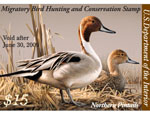|
2008 Federal Duck Stamp Contest
Phone: 612-713-5360 |
Missouri

Click here to download/view the U.S. Fish and Wildlife Service 2007 Missouri State Fact Book in .PDF format (File size: 3.2 MB)
Click here to download/view the Midwest Region Summary of Offices and Activities in PDF format (File size: 4 MB)
Links to Offices and Services in Missouri
National Wildlife Refuges
Big Muddy National Wildlife Refuge
573-876-1826Clarence Cannon National Wildlife Refuge
573-847-2333Great River National Wildlife Refuge formerly Annada District
573-847-2333Mingo National Wildlife Refuge
573-222-3589Ozark Cavefish National Wildlife Refuge
573-222-3589Pilot Knob National Wildlife Refuge
573-222-3589Middle Mississippi River National Wildlife Refuge
217-224-8580Squaw Creek National Wildlife Refuge
660-442-3187Swan Lake National Wildlife Refuge
660-856-3323Ecological Services
Columbia Ecological Services Office
573-234-2132National Fish Hatchery
Neosho National Fish Hatchery
417-451-0554Fishery Resources
Columbia Fishery Resource Office
573-234-2132Law Enforcement
Independence Law Enforcement Office
816-461-5245St. Peters Law Enforcement Office
314-441-1919Other Programs
Federal Aid
Migratory Bird Conservation
North American Waterfowl Management Plan
Private Lands Office
RealtyOther Information
State Capital
Midwest Natural Resources Group (MNRG)
Missouri State Facts
Employment: The Service employs more than 84 people in Missouri
The Fiscal Year 2006 Resource Management budget for Service activities in Missouri totaled $6.5 million
Ten National Wildlife Refuges in Missouri total more than 60,831 acres
In 2004, more than 239,000 people visited national wildlife refuges in Missouri to hunt, fish, participate in interpretive programs and view wildlife
Federal Assistance to State Fish and Wildlife Programs
In 2006 Missouri received:
$9.6 million for sport fish restoration
$7 million for wildlife restoration and hunter education
Missouri River Endangered Species
The Columbia Field Office helped develop a biological opinion on the impacts of Missouri River dams and navigation operations on endangered and threatened species. The Service provided the U.S. Army Corps of Engineers with an assessment of including the pallid sturgeon and least tern — and provided recommendations to minimize impacts as river operations continue.
Conserving Mississippi River Wetlands
The Columbia Field Office continues to provide input to the Corps of Engineers on the impacts of a proposed flood control project along the Mississippi River that would jeopardize the state’s last remaining wetland connected to the river. The Service has provided information on expected impacts of the project and alternative ways to accomplish project purposes while conserving irreplaceable wetland habitat for fish and wildlife.
Bagnell Dam
The Columbia Field Office is participating in a review of the Osage Hydroelectric Relicensing Project, specifically Bagnell Dam, which created Lake of the Ozarks. The office participates in stakeholder meetings and works closely with the Missouri Department of Conservation and others to address the loss of endangered freshwater mussels below the dam.
Keeping Communication Open
The Columbia Missouri Field Office reviews 300 to 500 cellular communication tower projects each year. The Columbia Office has come up with a streamlined process to review projects so that delays are avoided while impacts to migratory birds are considered. The streamlined process has provided an effective outreach and education tool that is paying off in a noticeable reduction in the number of cell towers posing threats to migratory birds. Feedback indicates communications companies are building more migratory bird friendly cell towers in Missouri as a direct result of Columbia’s streamlined review and concurrence process.

